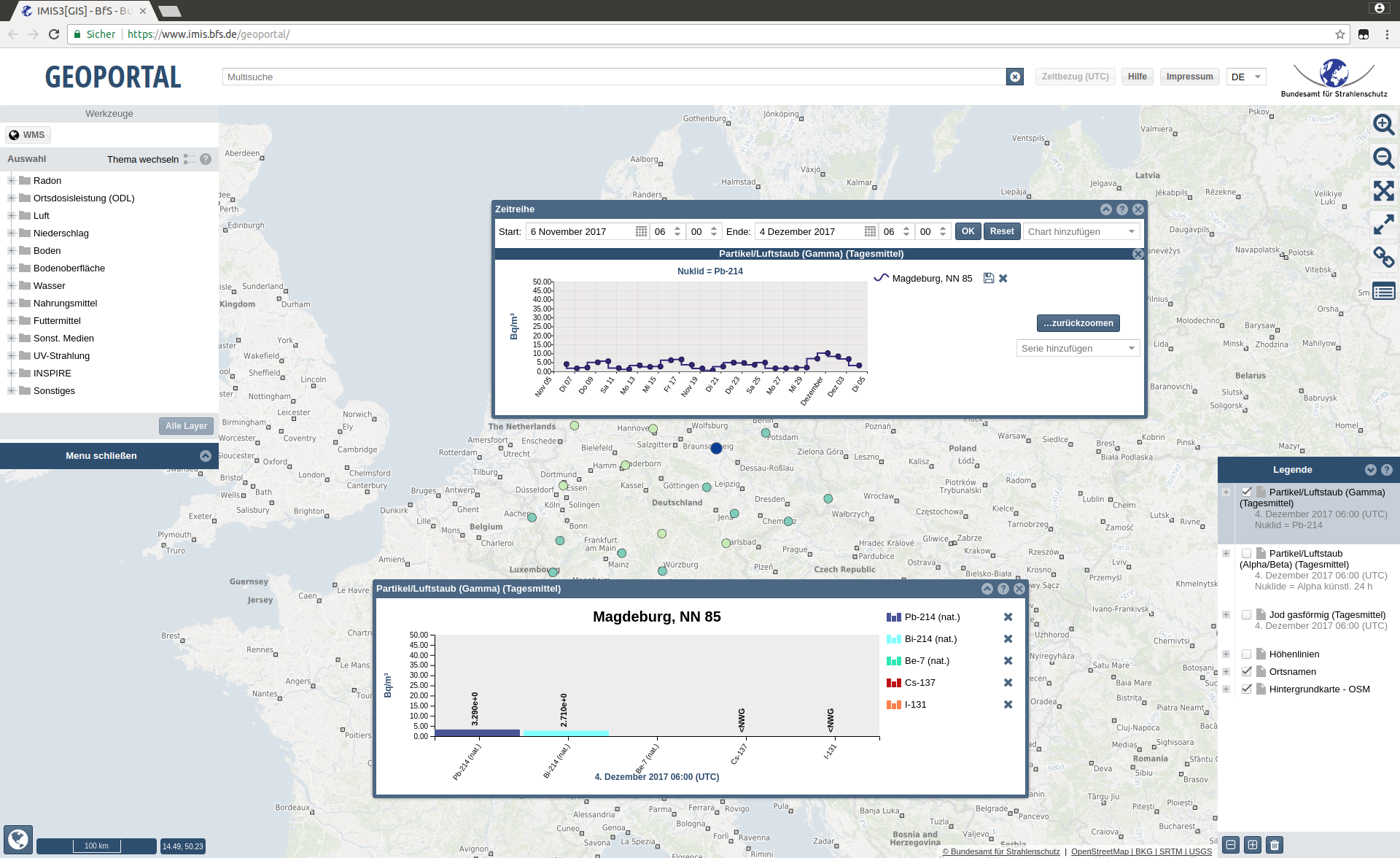In the case of increased nuclear radiation readings it is necessary to implement fast and target-oriented measures in order to protect the population. On behalf of the German Federal Office for Radiation Protection (BfS), terrestris is developing a modular application that processes data from more than 2,000 measuring points throughout Germany in order to make it available when quick decisions are needed.
Nuclear power phase-out is a done deal. Nevertheless, the cases of Chernobyl, Fukushima, and, more recently, the discussions about the safety of the nuclear reactor near the Belgian village of Tihange, have shown that radiation protection will continue to be on our agenda.
But what is to be done in case of an emergency, for example when a reactor accident results in a leak of nuclear radiation? Suitable protective measures are only made possible by readily available and reliable information on (and predictions of) radioactive clouds or the contamination of the environment.
On a federal level, it is the German Federal Office for Radiation Protection (BfS) that is responsible for emergency preparedness. The office uses the Integrated Measuring and Information System (IMIS) for the monitoring of radioactivity in the environment. Commissioned by the BfS, the Bonn-based company terrestris has developed a configurable application for an optimal monitoring of the collected data.
At around 1,800 measuring points that are spread across Germany, IMIS continuously measures nuclear radiation in the environment. Added to this is a great number of measured data from other institutions, such as Germany’s National Meteorological Service, the German Federal Institute of Hydrology, and the State Offices responsible for the environment and nature. Furthermore, IMIS collects measured data from more than 60 laboratories as well as measuring stations located abroad.
 The Application can be configured individually
The Application can be configured individually
All this data is made accessible to the public via the geoportal and can be accessed on the Internet. “Thereby we fulfill our legal obligation to make the collected data transparent and publicly available”, sais Sven Burbeck from the BfS.
The new application makes it possible to integrate this data into maps and diagrams that can be configured according to one’s needs. One click suffices in order to modify the map with the help of additional features: e.g. changes in scale or zooming, filtering and editing for the search of locations, or continuously updated time series for measured precipitation.
“A map is worth a thousand pictures”, explains Till Adams, CEO of terrestris. “The point was not to generate statistical images. Instead, we bring data together into an interactive map. Thereby, it is possible to represent the data in accordance with specific questions”.
The BfS uses the developed software mainly in order to attend to their tasks in the realm of emergency management. What is more, parts of the application are used in order to make the information available to the public via the Internet (https://www.imis.bfs.de/geoportal/).
With the geoportal the BfS makes a contribution to the transparent representation and publication of administratively collected data, thereby making it possible for the data to be used by a wider public.
Processing a great amount of data
With the help of IMIS the BfS permanently monitors radioactivity in the environment. A probe is located approximately all 20 kilometers. In the area of nuclear power plants, there is a larger amount of probes. Every measuring point constantly measures the local dosagerate. Normally, this is the natural radiation load constituted by radionuclides in the air and soil, as well as cosmic radiation from space.
Single pieces of data are useless for the evaluation. What is needed is data that spans longer periods of time. This data has to be directly available, so that, in the case of an emergency, it is possible to quickly assess a contamination and to gauge the radiation load that is to be expected. In order to gather the necessary measurements the probes can be sampled every 10 minutes. “This leads to a huge and diverse amount of data, which we can then immediately represent multi-dimensionally in maps and charts”, explains Ulrich Rothstein, project manager at terrestris. In this way, a radioactive cloud can be observed in real time.
Apart from its features for visualization and filtering, the application fullfils another important requirement: it offers the possibility for printing. Every map can be transformed into a PDF file and thereby into a printable document – an important prerequisite for administrative decisions, which have to be well-documented, partly in order to be valid for legal purposes.
 Geo-infrastructure with open source
Geo-infrastructure with open source
In the context of radiological emergency management the project is also connected to an international network. The collected data is immediately exchanged with the authorities at federal and state levels in neighboring countries and the EU. Therefore, it is also possible to use the WebGIS-application in order to visualize the measurements of other administrations.
In order to further develop its system for the monitoring of radioactivity, the BfS relies on open source. For the developers at terrestris, this means that they are not expected to simply develop a new software, but to integrate the new application into existing open source structures of the BfS.
In creating the application the developers used open source components like OpenLayers in order to represent the data in the web browser. GeoServer was used for processing the geographical data and site-specific information, while MapFish was deployed for printing the maps as PDF. In addition, GeoNetwork open-source and GeoExt were utilized.
Collaboration as a transfer of knowledge
Legal revisions and changing requirements for user friendliness ensure that the application has to be refined continuously. Therefore, the cooperation does not end with the development of the software.
“New questions around the data to be processed arise that need to be solved. Thus, the cooperation with the Federal Office is close and full of trust”, says Ulrich Rothstein. “The code will be updated, the software maintained and optimized. Our field of duties also includes the training of developers at the BfS. In this respect, we understand our work as a transfer of knowledge, which can be profitable also for the public”.
In this way the application can, like all open source solutions, be used and further developed by other interested parties, administrations and companies that concern themselves with similar issues.
